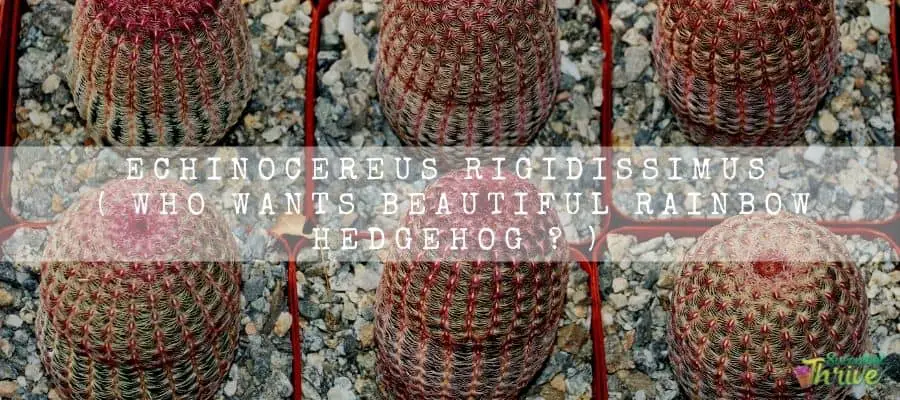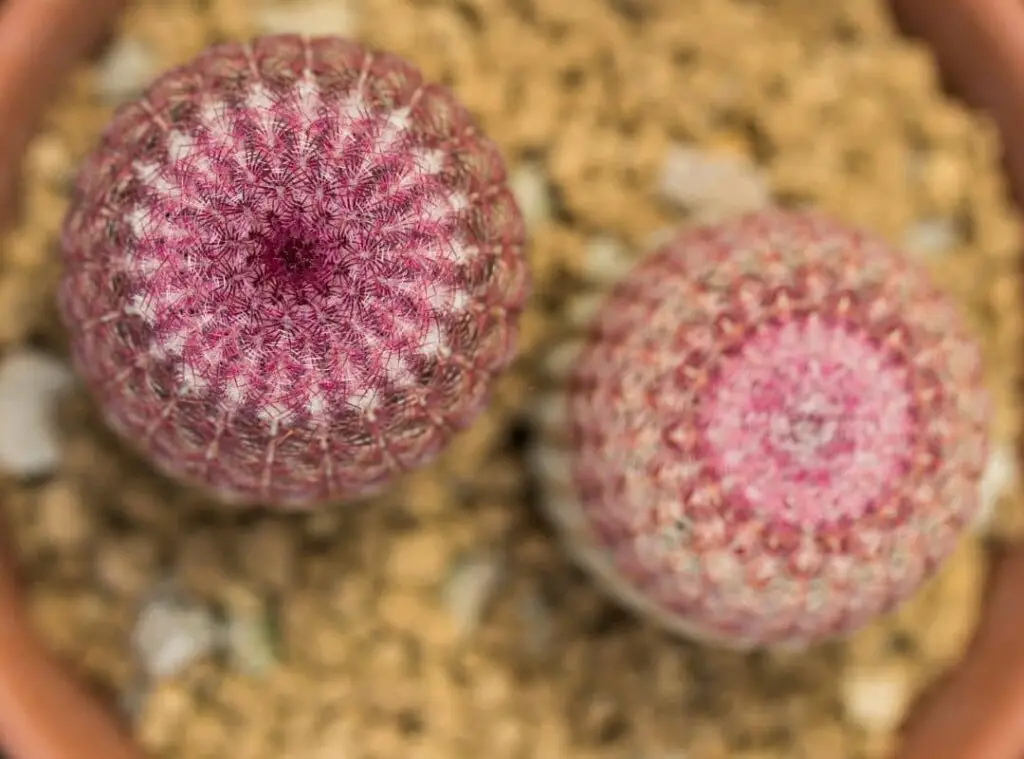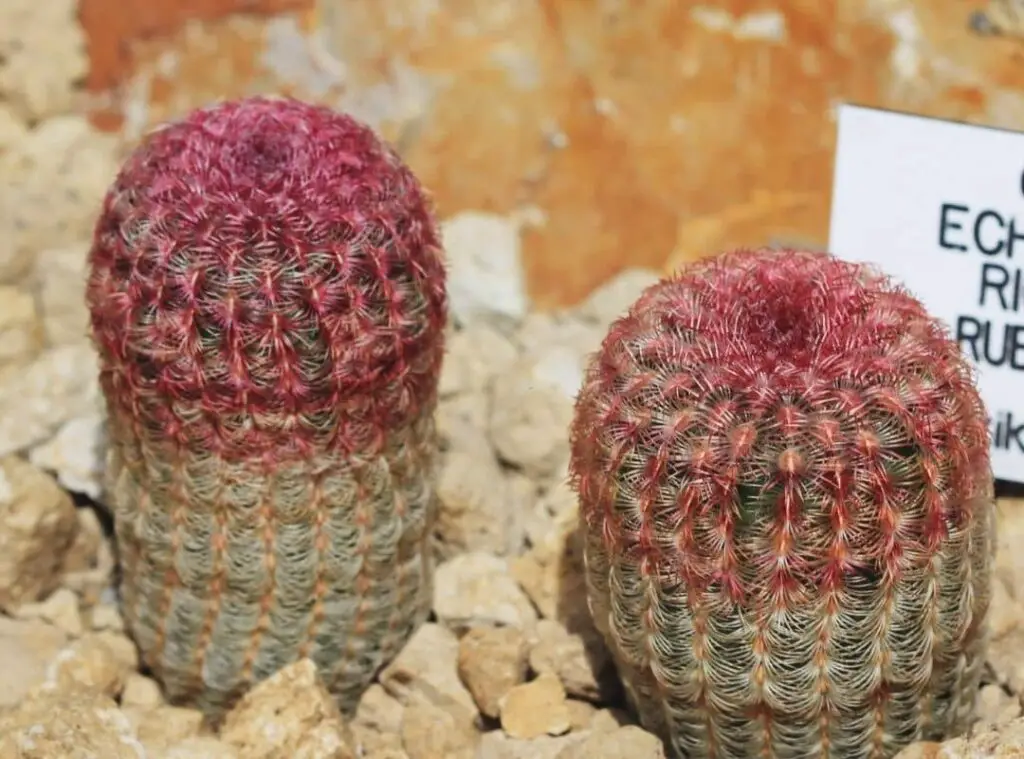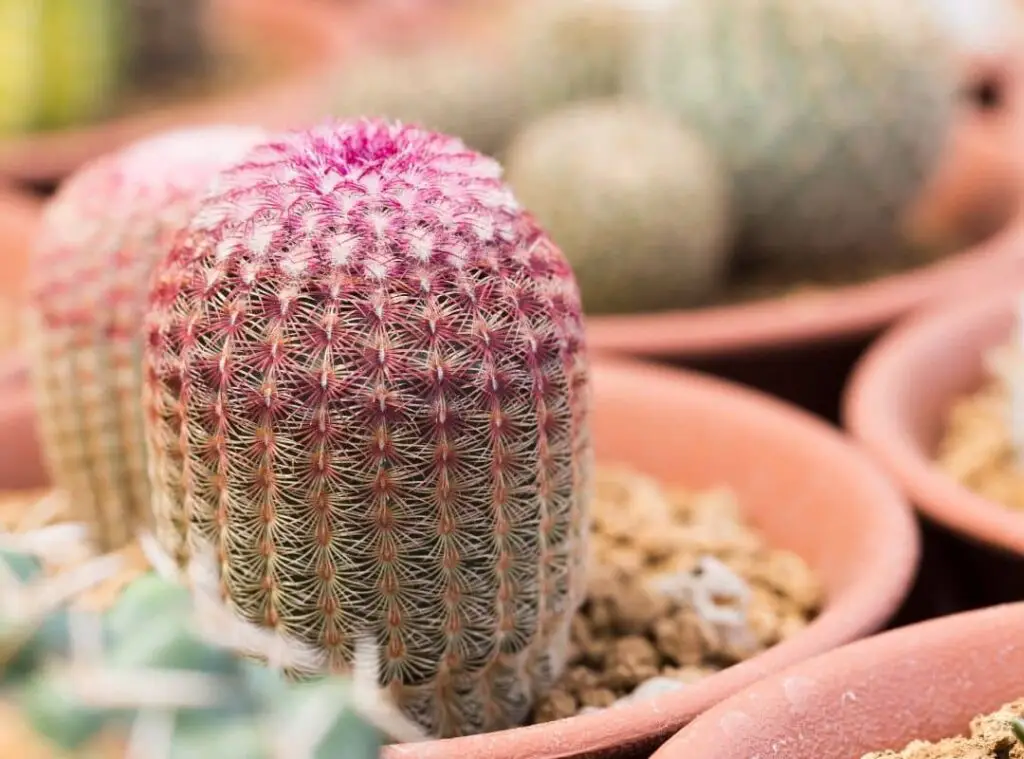Echinocereus rigidissimus or Rainbow Hedgehog Cactus are endemic cactus to Mexico and to the USA. You could spot them growing on rocky slopes in those countries.
They are also easy to care for. Moreover, Echinocereus rigidissimus are an evergreen set of plants. Further, this is becoming a trendy plant due to their attractive looks.
You may consider growing these plants even if you are a beginner in gardening.
You could spot Echinocereus rigidissimus growing as solitary stems and it is very unlikely that you could spot them producing offsets.
We are going to cover the growing care treatments and their propagation methods in this article. So, if you wish to find out about these amazing plants, continue reading this article.

How do I identify Echinocereus rigidissimus?
Echinocereus rigidissimus cactus would get as tall as 12 inches (about 30 cm) in height. In terms of the diameter, they would be about 4.4 inches (11cm).
They consist of magenta-colored spines, and they would become yellow or light pink as they mature.
Echinocereus rigidissimus cactus stem is pale in color and its upper part could turn red later on.
This is one of the crucial factors which you could use to identify the Echinocereus rigidissimus cactus. In addition to these factors, you could use their flowering factor also to identify them.
In fact, they would produce flowers in bright pink and their inner part would be white in color.
One look care guide
| Botanical Name | Echinocereus rigidissimus |
| Common Name | Rainbow Hedgehog Cactus |
| Plant Type | Succulent |
| Mature Size | 30 cm (12 inches) in height diameter 11 cm (4.4 cm). |
| Sun Exposure | Full Sunlight to partial sunlight |
| Soil Type | Sandy, gritty, well-draining |
| Soil pH | 5.0-7.0 |
| Bloom Time | Spring |
| Flower Color | Pink |
| Hardiness Zones | USDA hardiness zones are 9b-11b ( -6.7 degrees Celsius) – 20 degrees Fahrenheit. |
| Native Area | United Stated and in Mexico |
| Toxicity | Nontoxic |
| Average price | 8 USD |

How do you take care of Echinocereus rigidissimus?
Light Requirement
Echinocereus rigidissimus cactus used to grow in hot and dry weather conditions and in full sunlight.
Hence when you grow them indoors, ensure that you mimic the same conditions as when they grow in their natural habitat.
Make sure you supply them with eight hours of sunlight on a daily basis. Having said that, they can thrive with five to six hours of sunlight as well.
Temperature and humidity
When it comes to the temperature and humidity aspect of these plants, they require warmer temperature levels and low humidity levels.
They are tolerant of temperatures more than 70 degrees Fahrenheit. Furthermore, they can withstand cold temperatures up to 10 degrees Fahrenheit too.
Is it cold hardy?
As aforesaid Echinocereus rigidissimus cactus are cold hardy up to 10 degrees Fahrenheit.
USDA Hardiness Zone
Echinocereus rigidissimus cactus’ preferred USDA hardiness zones are 9b-11b ( -6.7 degrees Celsius) – 20 degrees Fahrenheit.
Watering Requirement
Echinocereus rigidissimus cactus usually grows in hot and dry weather conditions.
However, when you water them, ensure that you water them thoroughly whilst making sure the soil is fully saturated.
Most importantly ensure that you let the soil wither between two watering sessions. If you are unsure whether the soil is dry or soggy, it would be safer if you wait for a couple of days and then water.So that you will not create any water logged situation.
There will be less repercussions of under watering when compared to over watering simply because these are drought tolerant plants and over watering could create severe repercussions on the plants.
For example, if you supply them with excess water, it could lead to root rot which could even turn out to be fatal on the plants.

Soil Requirement Type / pH
Echinocereus rigidissimus cactus requires a gritty soil mix which has excellent drainage. You may go ahead with a cactus soil mix or with a succulent soil mix for this purpose.
Alternatively, you could use an amended soil mix whilst mixing regular potting medium with sand and pumice at a ratio of 2:1.
When you add elements such as sand and pumice, it would be effective in fastening the draining and developing the texture in the soil mix.
If you live in a dry zone, you could grow them as outdoor plants without shifting them indoors and you could go ahead and plant them in the soil without amending it any further.
Pot size Potting and Repotting
Clay containers would be ideal to grow these plants. In addition to that, ensure it has sufficient draining holes.
When you consider repotting the Echinocereus rigidissimus cactus, you do not need to do it on a frequent basis.
You may only do it once every three years. Further, the best time to conduct reporting is spring.
You need to repot them when you freshly purchase them from the stores. Apart from that if your Echinocereus rigidissimus cactus have become repotted, you need to repot them in a slightly larger pot than what it was planted before.
When repotting you could go ahead with a cactus potting medium which consists of sphagnum peat moss and coarse sand.
If you use a regular potting medium which is slow draining, it will lead to root rot and to stem rot as well. To start off, first you need to fold a newspaper and make a long narrow band and wrap around the cactus.
When you wrap the cactus, ensure that you wrap it like a sling. Further try to take the cactus slowly and gently out of the pot.
If you cannot take the plants easily out of the pot, you may use a butter knife and loosen the soil and take the plant out of the pot.
When repotting, you should make sure that you do not harm the root system . Furthermore, do not leave the repotted specimen under direct sunlight too.
Further suspend watering them for one week’s time. After one week’s time only, you need to water them regularly. Suspend feeding them for one months’ time too.
Where to Plant
You need to plant them in a soil mix which has an excellent drainage which is porous. When you grow them in a well-draining soil mix, it will avoid any waterlogged condition in the pot.
Ensure that you add on the aforesaid elements to fasten the draining of the soil mix. Furthermore, you should keep the specimen where they can gain partial sunlight to full sunlight.
Hence you could grow them outdoors. Having said that, you could grow them indoors as well.
However, when you grow them as houseplants, make sure that they get direct sunlight right throughout the day.
Moreover, if they still lack proper sunlight levels, you may grow them closer to artificial lights as well. However, it is best to grow them under natural sunlight.
No matter where your plants are, you should be vigilant to not expose them to extreme heat since it would be harmful for the plants.
Furthermore, if you have planted your cactus outdoors and if you expect any extreme winter weather conditions, you need to bring them indoors to protect them.
Fertilizer and time of year
Echinocereus rigidissimus cactus do not want to be fed on a frequent basis. Having said that, you could consider adding some quantity of fertilizers when they are in their actively growing phase.
The growth of the plants would be benefitted from that as it will provide an extra stimulation for the vigorous growth of the plants.
You could proceed with a cactus or a succulent fertilizer when feeding them. In terms of the frequency of feeding, it would be once a month during their active growing season.
Dormancy
Echinocereus rigidissimus cactus would go dormant in extreme winter conditions.
Toxicity
Echinocereus rigidissimus cactus are not poisonous for pets and for humans as well.

Common bugs and illnesses
Echinocereus rigidissimus cactus are hardy plants and they are resistant to pests’ attacks and diseases as well.
If you end up supplying them excess water, chances are that the plants may suffer from root rot. In addition to that you need to watch out for regular pests like mealybugs, aphids, and scale.
It is critical that you attend to these pests’ attacks well in advance unless they could create severe repercussions.
To treat them, you may use an insecticidal soap. You could find the diluted insecticidal spray bottles in the stores and use them every other day.
However, if the pests have spread to a severe level, you need to get rid of the plants.
Special Care tips
Echinocereus rigidissimus cactus could be easily maintained. However, if you spot your cactus has become root bound, you need to consider repotting them.
Further it would be better if you could keep the plants under your observation on a regular basis so that you could identify if there are any early signs of any issue.
Flowering
Echinocereus rigidissimus cactus would usually bloom in spring. Further, their flowering season would be from late April to early June.
Moreover, those flower buds will arise in clusters right in the upper part of the cacti. Echinocereus rigidissimus cactus flowers would be bright pink.
If you do not provide the right growing conditions, you cannot expect these plants to flower.
However, you could consider watering them more and expose them to supply them with sufficient sunlight levels to stimulate the flower blooming of the plants.

How to propagate Echinocereus rigidissimus
You could use their cuttings and seeds to conduct propagation of the Echinocereus rigidissimus cactus.
When you use the cuttings to propagate them, you need to first snip off a healthy-looking leaf whilst using a clean knife or scissors.
However, ensure that you leave the cuttings in a warm and dry place. The purpose of leaving them in a dry place is to allow them to develop callousness. Next you may go ahead and plant them in a well draining soil mix.
When you use their seeds to propagate the Echinocereus rigidissimus cactus, keep in mind they are slow growing, and it would not be as effective as the aforesaid cutting method.
However, if you still wish to try this method, you simply have to plant them in a well-draining soil mix.

Related questions
What is an Echinocereus used for?
Echinocereus in general are known for the tastiest fruits among all cacti types.
Some people burn these plants to remove the spines and consume the fruits raw. In addition to that they use the stems to form into a pulp and utilize it for some good and candy manufacturing.
Is there such a thing as a rainbow cactus?
Yes there is. It usually grows as solitary, and it is very unlikely that you could spot them branching or producing offsets.
Conclusion
Before wrapping this up, I hope you are now well aware of handling the Echinocereus rigidissimus and on their appropriate growing requirements.
As you may already understand they are easy to care for and all you need to do is to supply their main growing requirements.
One more interesting feature to have is their flowering activity. Happy gardening with Echinocereus rigidissimus.
Read More : King Cup Cactus Care Facts ( A Cactus With Gorgeous Flower ) Is Coral Cactus Toxic? 9 Important Facts You Must Know Why My Coral Cactus Dying? And How I Solve That Problem
